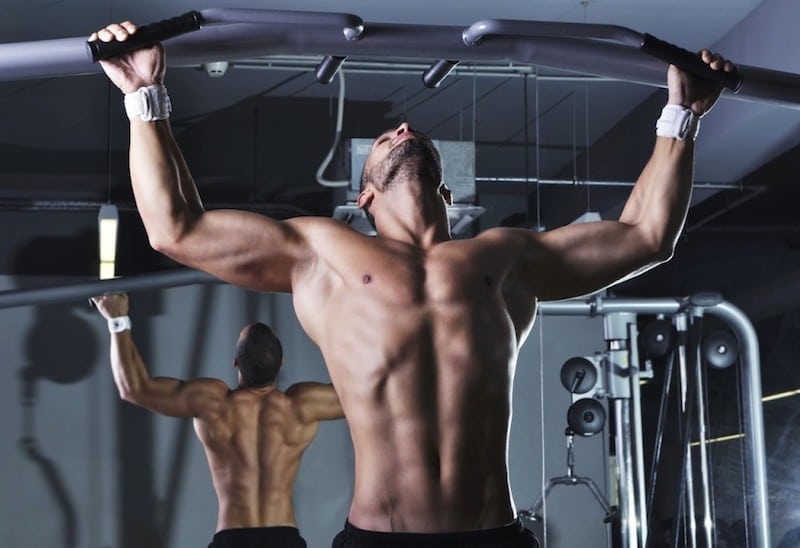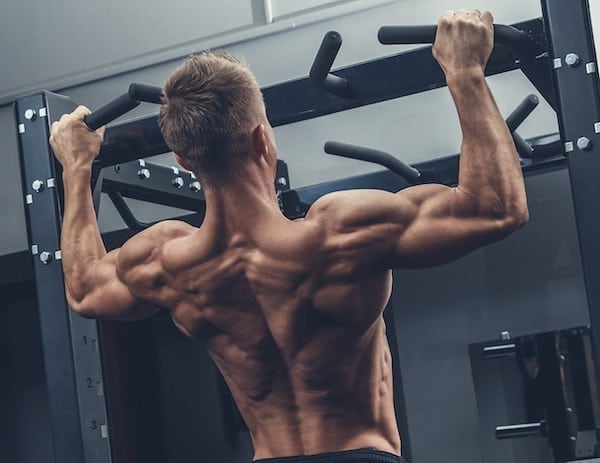No products in the cart.
7 Benefits of Pull Ups: Why and How to Perform Pull Ups?

Performing a set of ten pull-ups with perfect form is one of the most satisfying things that you can do in the gym.
Not only does it work a lot of muscles, but it demonstrates that your strength to body weight ratio is excellent.
In this article we will first talk about how to perform the perfect pull up, look at some common variations, and then we will describe seven benefits of performing pull-ups on a regular basis.[toc]
The Muscles Worked During a Pull-Up
There are several major and minor muscles that are worked during a pull-up.
The emphasis placed on each muscle can be affected by technique. For example, using a supinated grip (hands gripping the bar and facing towards you) will place more emphasis on the biceps brachii and less on the latissimus dorsi muscles.
The muscles worked are mostly in the upper back, shoulders, and arms, but your abdominals will also be slightly worked, as you need to brace your abs properly during a pull up to maintain good posture.
Muscles worked:
- Latissimus Dorsi
- Trapezius
- Rhomboids
- Teres Major
- Brachioradialis
- Brachialis
- Biceps Brachii
The major muscles worked during a pull up are the lats, traps, and biceps. The other muscles are also worked but contribute less.
How to Perform a Perfect Pull Up
A proper pull-up uses an overhand grip. Grab a pull up bar using a wide-ish grip. Make sure that the bar is high enough up that you can hang from it without touching the floor. Push your chest out and pull your shoulder blades backwards slightly.
Your hands should be about shoulder width apart, maybe a little wider. Take a deep breath and then pull your chest up to the bar. Keep your elbows flared out while pulling yourself up, they should travel in an arc.
Once your collarbone is in line with the bar you should pause, and then slowly lower yourself back down again. Concentrate on travelling back down slowly, you really don’t want to just “drop”.
Once your arms are almost (but not quite) fully extended, begin to pull yourself back up again. Repeat until the correct number of reps has been completed.
Variation #1: Chin Up
Instead of using an overhand grip you will use an underhand (supinated) grip, another difference between a chin up and a regular pull up is that the hands are a lot closer together. This places much more emphasis on the biceps and trapezius, and less on the latissimus dorsi.
The chin-up is also quite a bit easier. Chin ups are often talked of as one of the most underrated biceps exercises.
Variation #2: Negative Pull Ups
If you can’t perform a proper pull up yet, you may be able to perform negative pull-ups instead.
This is where you avoid the pull-up part and concentrate instead on the lowering down from the pull-up bar. This is known as the eccentric part of the movement.
Performing a pull up using exclusively the eccentric part will be a lot easier, but will really help build strength in the relevant muscles. All you need to do is place a box underneath the bar, and use it to climb to the top of the movement. Afterwards, you lower yourself as slowly as possible to the floor.
Variation #3: Wide Grip Pull Ups
This variation is different to the others in that it actually makes pull-ups more difficult, rather than less difficult. The benefits of using a wider grip are that it places more emphasis on the latissimus dorsi.
To perform a wide grip up you set up exactly the same as a regular pull up but instead of having your hands just wider than shoulder width apart, you bring them slightly wider apart.
Variation #4: Assisted Pull Up
Some people will not be anywhere near strong enough to perform a full pull up, luckily there are a couple of options that are available to them.
Many gyms have assisted pull up machines, that use a counterweight to remove some of your body weight from the equation.
If you weigh 90kg you can set the assisted pull up machine to take off 30kg of your weight and instead you’ll only have to lift 60kg.
Alternatively, you can use bands wrapped around the bar, which take away some of your weight and make it easier to pull yourself up.
Benefits of Performing Pull Ups

Now we know what a pull up is, what muscles it works, and how to perform one (and several variations of one), it is time to look at why we would want to.
Below we are going to look at 7 benefits of performing pull ups [1][2].
Benefit #1: Pull Ups Can Improve Posture
A lot of the muscles that were used in the pull up are in the upper back and around the shoulder blades.
The Rhomboids and Teres Major are small muscles in your upper back, they help with shoulder stability, and can also contribute to better posture.
The bigger muscles, particularly the trapezius muscles are also important if you want to maintain good posture.
When performing a pull up you are supposed to push your chest out and pull your shoulder blades backwards. This technique will leave you with a flat back and is excellent for posture.
Learning how to get the right posture for pull-ups will help improve your posture for many other exercises such as the deadlift, bent over row, seated row, low row, Romanian deadlifts, good mornings, and hundreds of other exercises.
Benefit #2: Pull Ups Strengthen Your Latissimus Dorsi
When Gym Bros talk about getting their wings, they are talking about building big lats.
You can do this with a number of exercises. Lat Pulldowns (obviously), barbell bent over rows, single arm rows, low rows, seated cable rows, and straight arm pulldowns. But a properly performed pull up is the absolute best exercise for building impressively large lats.
This is doubly true if you are performing wide grip pull ups, but even a close grip chin up will work those lats hard.
At first, pull-ups may not be great for hypertrophy because your rep range will be short, but they will be excellent for lat strength.
Then, as you progress you’ll be able to do higher and higher reps. You can also add in weighted pull-ups (using a pull-up belt) to further stimulate muscle growth.
Benefit #3: Pull Ups Strengthen Your Trapezius Muscles
Your traps are another very popular muscle group that is beloved by bodybuilders, someone with huge traps is often referred to as being “yoked”.
Now, a pull up is not the ultimate trap building exercise in the same way that it is the ultimate lat building exercise. But it does really work the trapezius muscles – particularly the lower portion.
Benefit #4: Pull Ups Can Help to Reduce Shoulder Issues
Many of the muscles worked during a pull up are involved in improving posture (as we mentioned earlier in this article). Those same muscles can help to reduce certain shoulder issues.
This may come as a surprise to some readers because many people report feeling pain in their shoulders when performing pull-ups.
This is almost always down to one of two reasons. Either the pull-up performer is using bad technique, or they have a pre-existing condition.
If you are suffering from shoulder pain during pull-ups, then check your form and consider making the exercise easier (adjusting grip width, changing to underhand, using bands etc).
But if you have healthy shoulders and are looking to reduce your risk of shoulder pain, learning how to perform perfect pull-ups, and doing so regularly will strengthen the lats, traps, rhomboids, and teres major muscles. All of these can help prevent rotator cuff injuries, rear delt injuries, and similar posture-related injuries.
Benefit #5: Pull Ups Can Build Bigger Biceps
Most people think of the dumbbell or barbell bicep curl as the ultimate bicep exercise.
Think about it, what’s the maximum amount of weight you can curl? 25kg? 50kg? Whatever it is, it probably isn’t as much weight as you can lift when performing a body weight or weighted pull up, is it?
Chin ups target the biceps hard, and you can perform a number of reps – which is great for hypertrophy.
Don’t believe us? Well, go perform 3 sets of 10 perfect chin-ups, with a nice slow technique during the eccentric phase. Then wake up the next day and tell us where you feel the ache most.
Guaranteed that you will be feeling your biceps like never before! We’re not saying that chin-ups should replace regular, targeted bicep exercises. We’re just saying that chin-ups will compliment these exercises incredibly well.
Here’s a suggested bicep workout which incorporates chin ups:
- Chin Ups – 3 x 12
- Barbell Bicep Curls – 3 x 15
- Dumbbell Hammer Curls – 3 x 12
- Assisted Chin Ups – 2 x 20
Benefit #6: Pull Ups Look Cool
Okay, so this benefit is a little more superficial than any of the others, and won’t necessarily appeal to everyone. But it is undeniable, to an untrained person being able to perform a proper pull up for a number of reps is an impressive feat.
There are videos up on YouTube that exclusively show people performing elaborate pull-up variations. You also get this with push-ups.
There is probably a part of you (no matter how small) that enjoys showing off. If you don’t have this then spend 6 months in a gym – it will come!
You’ll never impress anyone with a lat pulldown. Ever. It doesn’t matter if you can max out the lat pulldown, it just doesn’t impress people. But walk into a gym, find a pull-up bar, and immediately knock out 20 perfect pull-ups in a row? You’re going to impress people.
Benefit #7: Pull Ups Can Be Performed Outside The Gym
Body weight training is all the rage at the moment, also known as callisthenics.
The idea that you don’t need to have a fancy gym membership to build muscle is very freeing. You can build muscle at home, or in a park, or field.
One issue in body weight training has always been a lack of back exercises. But learning how to perform pull-ups can solve this issue.
Yes, you will need to find some form of bar to use. And it will need to be able to support your weight. But a proper pull-up bar can be relatively inexpensive, and you’ll be surprised at how many pull up capable bars are out there in the world. Many parks have apparatus that can be used for pull-ups.
Final Thoughts
Pull-ups are effective for building muscle, for increasing muscle size and strength, for improving overall strength.
They can help improve your posture, reduce your injury risk, and help you build bigger biceps. There are many variations out there, we only looked at a few in this article.
It may take you a while to master them, start with assisted pull-ups. Either from an assisted pull up machine, or by using resistance bands to work as a counterweight. You can also start to perform negative pull-ups where you concentrate on the eccentric part of the pull-up.
After that, you can progress to chin ups. Then look to trying regular pull-ups or even wide grip pull ups.
Whatever route you take, always ensure that your form is perfect.
If you are struggling to perform the pull up perfectly, then find an easier version, or reduce the number of reps per set. Quality over quantity at all times.
Remember, to see the full benefits of pull-ups you will need adequate nutrition from your diet (information here), plus adequate sleep (7 hours minimum each night). Taking a muscle builder that can boost performance will also be a big help.
